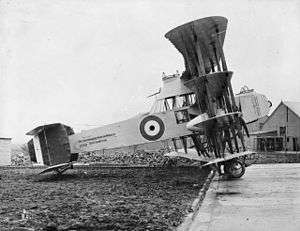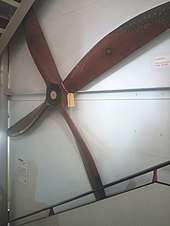Supermarine Nighthawk
The P.B.31E Nighthawk, the first project of the Pemberton-Billing operation after it became Supermarine Aviation Works Ltd., was a prototype anti-Zeppelin fighter with a crew of three to five and an intended endurance of 9–18 hours. It was first flown in February 1917 with Clifford Prodger at the controls.[1]
| P.B.31 Nighthawk | |
|---|---|
 | |
| Supermarine Nighthawk | |
| Role | Anti-Zeppelin fighter |
| National origin | United Kingdom |
| Manufacturer | Supermarine |
| First flight | 1917 |
| Status | Prototype only |
| Number built | 1 |
| Developed from | Pemberton Billing P.B.29E |
Design and development
The Nighthawk had six-bay swept quadraplane wings and a biplane tailplane with twin fins and rudders. The fuselage filled the gap between the second and third wings; the cockpit, which carried up to the top wing "turret", was enclosed and heated.
Along with the intended long endurance, it was suggested it would be able to patrol at low speeds and await the Zeppelin.[2] For armament, it had a trainable nose-mounted searchlight, a 1½-pounder (37 mm) Davis gun mounted above the top wing with 20 shells, and two .303 in (7.7 mm) Lewis guns. Power for the searchlight was provided by an independent petrol engine-driven generator set made by ABC Motors, possibly the first instance of a recognisable airborne auxiliary power unit.[3]
Operational history
Although touted as being able to reach 75 miles per hour (121 km/h), the P.B.31E prototype only managed 60 miles per hour (97 km/h) at 6,500 feet (2,000 m) and took an hour to climb to 10,000 feet (3,000 m), which was totally inadequate for intercepting Zeppelins.[4] German airships, such as P, or R Class military Zeppelins were themselves capable of top speeds of around 60 miles per hour (97 km/h).[5]
Furthermore, given the Anzani engine's reputation for unreliability and overheating, it is unlikely that the aircraft would have delivered the advertised endurance.
Surviving relics

One of the two propellers of the Nighthawk is preserved in Solent Sky, an aviation museum in Southampton, England.
Specifications (Prototype)
Data from The British Fighter since 1912[1]
General characteristics
- Crew: 4 (2 pilots, 2 gunners)
- Length: 37 ft 0 in (11.28 m)
- Wingspan: 60 ft 0 in (18.29 m)
- Height: 17 ft 8.5 in (5.398 m)
- Wing area: 962 sq ft (89.4 m2)
- Empty weight: 3,677 lb (1,668 kg)
- Gross weight: 6,146 lb (2,788 kg)
- Powerplant: 2 × Anzani 10-cylinder air-cooled radial piston engines, 100 hp (75 kW) each
- Propellers: 4-bladed fixed-pitch propellers
Performance
- Maximum speed: 75 mph (121 km/h, 65 kn)
- Endurance: 9 hours normal ; 18 hours maximum
- Time to altitude: 10,000 ft (3,048 m) in 60 minutes
Armament
- Guns: One 1½-pdr Davis gun and one Lewis gun above upper wing, and one Lewis gun in the nose
See also
References
| Wikimedia Commons has media related to Supermarine Nighthawk. |
- Notes
- Mason 1992, p. 60.
- "Sires of the Switft", Flight: 462, 1953
- Andrews and Morgan 1987, p. 21.
- Bruce 1969, p. 69.
- Jon Guttman (9 March 2018). Zeppelin vs British Home Defence 1915–18. Bloomsbury Publishing. pp. 19–. ISBN 978-1-4728-2034-1.
- Bibliography
- Andrews, C.F. and E.B. Morgan. Supermarine Aircraft since 1914. London: Putnam, 1987. ISBN 0-85177-800-3.
- Bruce, J.M. Warplanes of the First World War, Volume Three: Fighters. London: Macdonald, 1969. ISBN 0-356-01490-8.
- Mason, Francis K. The British Fighter since 1912. Annapolis, Maryland: Naval Institute Press, 1992. ISBN 1-55750-082-7.